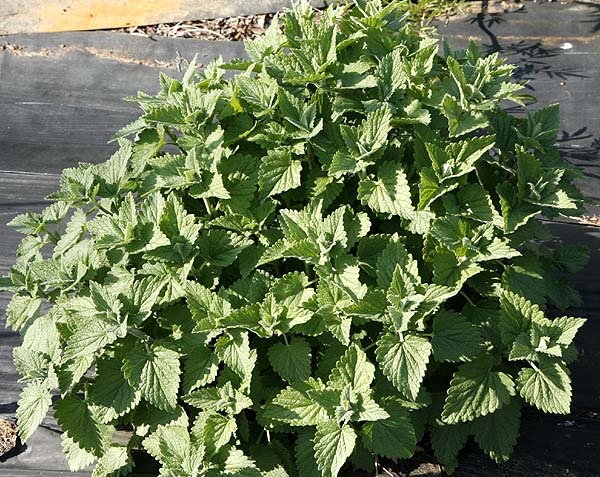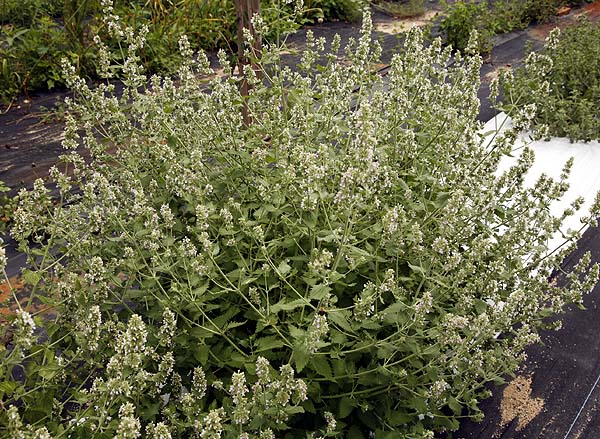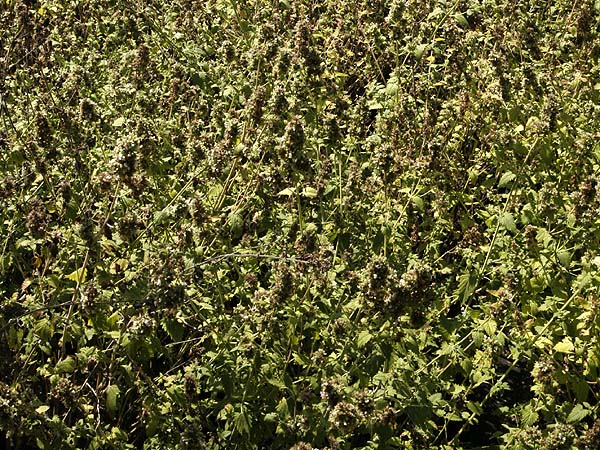STAGES IN THE LIFE OF A CATNIP PLANT.
Catnip has distinct stages of its life and its very important that it
is harvested at the right stage to get the best possible product. This
short guide will help you to understand those stages and then be able
to knowledgeably shop of the best product.
We think a very important question why buying catnip is
What kind of catnip are you actually getting when you buy it?
Even if you grow your own this guide can be of help determining when
the best time to harvest you catnip is. If you have cats and are not protecting
your catnip bushes this point may be a bit mute as they will most often
eat the plant as soon as it comes out of the ground.
Why all the fuss about types of catnip?
Before we look at the types of catnip its important to understand why its different. It's all to do with a substance called nepetalactone. This is the essential oil that catnip produces which is considered the 'active ingredient' in the plant. It's the substance that gives catnip it's distinctive odor that cats seem to love and most people find unpleasant - especially when the stuff is drying. The concentration of nepetalactone in the leaves varies as the plant grows and matures. While nepetalactone is considered to be the main 'ingredient' to catnip there are also many other compounds in the leaf that work together with nepetalactone to produce both the effects that are so distinctive in cats and the medicinal benefits to humans. As with most herbs these compounds have never been entirely identified but it is well known amongst scientists and herb professionals that these compounds work together to produce the effects they do. It is therefore important to collect leaves at a time when the concentrations are the highest if at all possible.
Catnip growth cycle.
This is 'a year in the life of catnip' as it growing. In actual fact it can be a lot less time than that depending on where the plant is growing, hot or cold climate, but in all cases the plant will go through these four stages if its not cut down beforehand.
Stage 1. Early growth. Occurs in early to mid spring.
With established catnip plants the shoots begin to come up in early spring. These have thick stems juicy stems, that often have a reddish or brownish tinge. They have lush fleshy green leaves and for the most part look really delectable even if you are not a cat. These leaves have quite a lot of nepetalactone and cats will eagerly seek out these new shoots if they can. At this stage the pliable fleshy stems also contain some of the essential oils which can be extracted via distillation if desired. These leaves are quite desirable and can be harvested if desired. The attraction for harvesters is that the stems are short and still contain oils. This means that they can be effectively combined in any catnip compound and still provide benefit. If only the leaves are to be used they are close together leading to less processing of the plant before drying. The stems are short and if dried with the leave are a very low proportion of the dry weight of the finished product. This is therefore a desirable plant stage.

Stage 1 catnip plant. Young vigorous stalks with lush leaves that are close together. Stalks are still short and unbranched.
Stage 2. Rapid lush growth. Late spring/early summer
Catnip plants start to grow taller. This is achieved by elongation of the fleshy stems. While the young plants had thick fleshy stems with leaves close together, now the stems get longer, thinner and less flexible, they begin to loose their fleshy nature. The plant looks taller but it's not as bushy as the leaves are farther apart but the stems are just beginning to branch. Flower buds begin to form at the top of the stems and flowers form.
At this stage, most experts agree, the plant contains the highest amounts of nepetalactone and other compounds. Stage one has nearly as many but not quite as much. Therefore this is the BEST time to harvest catnip. The leaves are still young and fresh they are fairly close together and the flowers are just beginning to bloom.
However the stems are now stiff and inflexible, they are basically just
a support system for the plant and they are also a much higher proportion
of the total plant bulk so if they are dried with the plant they will
be a much higher proportion of the finished produce, and they don't contain
any active ingredients.
If catnip is harvested at this time the leaves need to be removed from
the stems and the stems discarded. Sadly most catnip producers do not
do this and this 'dead wood' is a large part of the ground catnip that
is sold today.
Most experts also state that the flowers also contain fairly high concentrations
of nepetalactone at this stage which is why flowering tops of catnip are
considered very popular and often sold as 'gourmet' catnip. Cats given
flowering tops often head for the flowers first and go for the leaves
second. (however this will depend on the cat).

Stage 2 catnip plant. Leaves are still young, but stems have begun to elongate and started to branch. Flowers are appearing on the tops of the stems.
Stage 3. Full blooming Mid Summer.
Catnip comes into full bloom. At this stage plants can reach five feet
in height and be festooned with flowers. Catnip is a wonderful pollinator
plant, bees and butterflies love it. If you want to save the bees and
attract butterflies to your garden having a few catnip plants is a must.
However to reach this height the plant basically elongates it's stems
even more. Now they are extremely tough and woody. At the base they may
be half inch (13 mm) across and take sharp pruning shears to cut. The
leaves are now much farther apart the plant is no longer compact but diffuse
and more airy. The stems have also branched out. At each pair of leaves
on the main stem side branches have formed and also elongated taking the
few leaves there further away and rising up to produce more flower stalks.
This structure allows the pollinators to reach all the flowers easily.
However the leaves are now becoming a little 'worn' they may turn slightly
yellow or even a rust color. The leaves at the base of the plant turn
brown and wither. Leaves contain much lower concentrations of nepetalactone,
not quite the lowest yet, but close. While the flowers do still contain
higher levels of nepetalactone its lower than in stage 2 as some flowers
are past their prime while others are still starting to bloom.
By now it's really too late to harvest most of the catnip leaf. The leaves right at the top of the stems next to the flowering tops still contain fairly high concentrations of nepetalactone and many growers will harvest just the tops of the plant and the flowering tops at this point. The rest of the stem is basically useless for any medicinal or cat purpose.

Stage 3 catnip plant is in full bloom. Stems have elongated and side branches are fully developed with elongated stems too. Each branch is full of blooms but leaves appear fewer and smaller concentrated more at the base of the plant.
Stage 4. Seeding. Late Summer.
Catnip flowers turn to seed. The flower head turn brown and seed is produced. Smaller side stems of the plant will continue to produce flowers until later into the summer. The leaves, turn yellow, then brown and drop from the plant. Once the flowers start to seed the concentrations of nepetalactone drop dramatically and even cats will walk right past the plant and ignore it. There are no useful leaves to harvest at this point. This stage is only useful for seed collection. For most gardeners it is recommended that the plants be cut down before the seeds begin to form as catnip is prolific seeder and will spread right across the garden if the seeds are left.

Stage 4 catnip plant. Flowers have turned brown and gone to seed. Stems are long thin and very tough with small leaves at wide intervals on the stems. Most leaves are beginning to yellow.
Temperature and nepetalactone concentrations.
Research has shown that in many cases growing aromatic herbaceous plants in cooler more rugged temperatures produces higher concentration of the active compounds than those produces in hot wet climates. This is the reason that most catnip is grown in more northern states and Canada rather than warmer states. The concentrations of nepetalactone tend to be higher. This is of course not true with all plants but tends to be the case with plants that have evolved to live in cooler climates. If placed in a hotter environment they just don't produce as well. The same would be true of a tropical plant growing in a colder climate its not going to do as well as in its native plant range. This means that those growing catnip in Florida most likely wont produce as strong a product as those from New Jersey or other cooler states. In many cases plants need to have a period of cold during the winter to stimulate production of active compounds. Catnip does indeed seem to be one of these plants. While there are no research papers as yet that measure catnip growing in all locations it would be nice to see some. However it is regrettably doubtful anyone would fund such a study.
Which Catnip would you rather have?
When you look at the images above its not really hard to see which stages
of catnip you would rather have. It's 1 and 2. Perhaps the flowers in stage
3 but here the leaves are definitely not at their best. Make sure you know
at what stage the catnip you are purchasing was harvested so you can ensure
you have the best product. The images below will also help.
OTHER CATNIP INFORMATION
How to choose which catnip to buy.
Taking Care of Catnip Plants for best Production
Questions about Catnip products
How Floral Encounters Produces Catnip.
| Janice Hazeldine PhD is the owner and head grower of Floral Encounters an organic Medicinal Herb farm that is also a designated sanctuary for pollinators. |





